Service dog teams often reach out, during or after their formal training is over, because the handler and the dog both crave learning new skills and training together as a team. ELLAS Animals INC recommends many different types of further training like agility, search and rescue, dock diving, detection, and additional task/work training. One of our volunteer trainers has been teaching her dog to use buttons to talk and has shared an update with us.
Teaching a Dog to Use Buttons to Talk – by Katie Calahan
Last January I made a purchase from Fluent Pet to see if my service dog in training, Daisy, could learn to talk using buttons. Prior to setting up the buttons, I read How Stella Learned to Talk: The Groundbreaking Story of the World’s First Talking Dog by Christina Hunger and Teach Your Dog to Talk: a Beginners Guide to Training Your Dog to Communicate with Word Buttons by Stephanie Rocha and I watched a lot of videos of dogs using buttons to talk on YouTube and other social media. My intention was to teach Daisy to talk using buttons to clarify when she wanted out to go potty and when she wanted out to play.
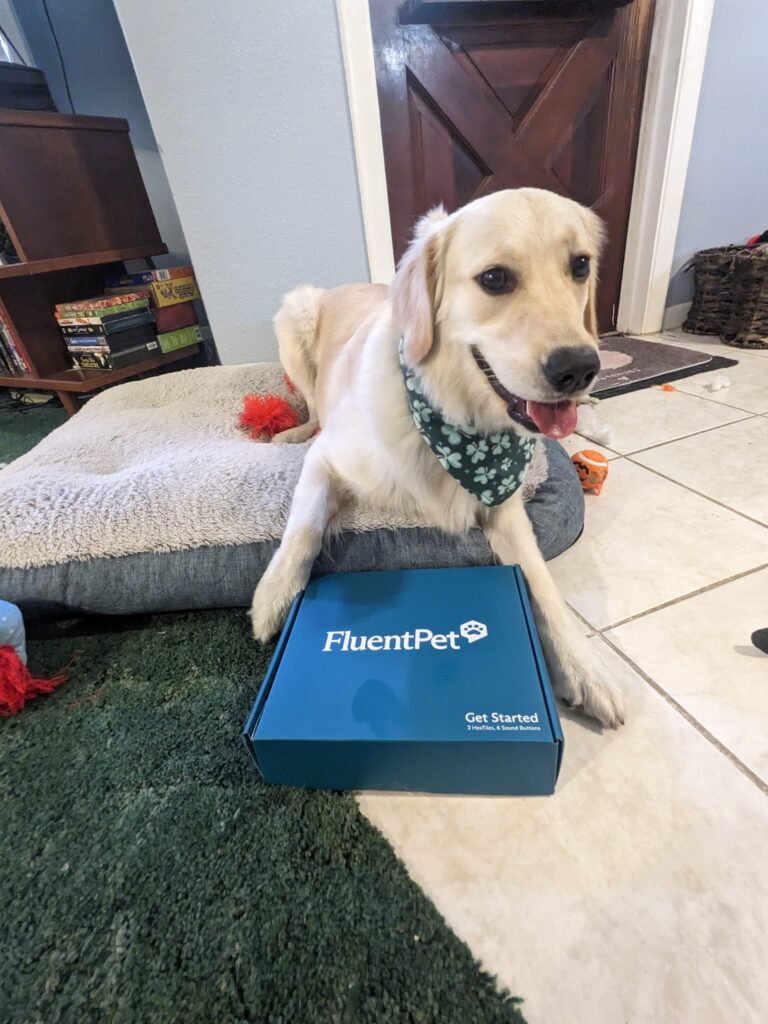
with her new box of buttons.
Set up for success to teach a dog to use buttons to talk
By the time the equipment arrived, as a goof, we had taught Daisy “paw”. It was a silly Instagram contest to do daily activities with your dog for a chance to win a gift card. One day the activity was “Learn a new trick” so I googled to find something simple to teach and made a video. We even won that week’s prize! Daisy got good at “paw”. Not only was she ready to push a button, but it had become her gesture for “want”. If we asked about something she wanted, she’d give paw to indicate. It is absolutely adorable. We talk to her constantly; we have some very consistent phrasing and we had “paw” going for us.
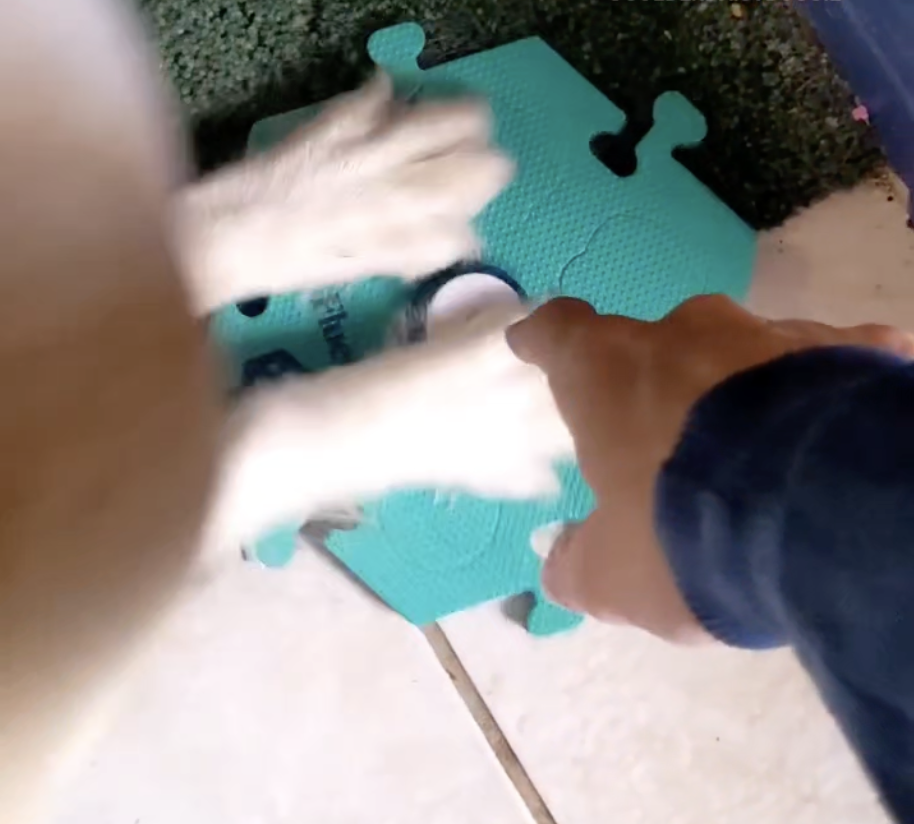
The first day and the first button
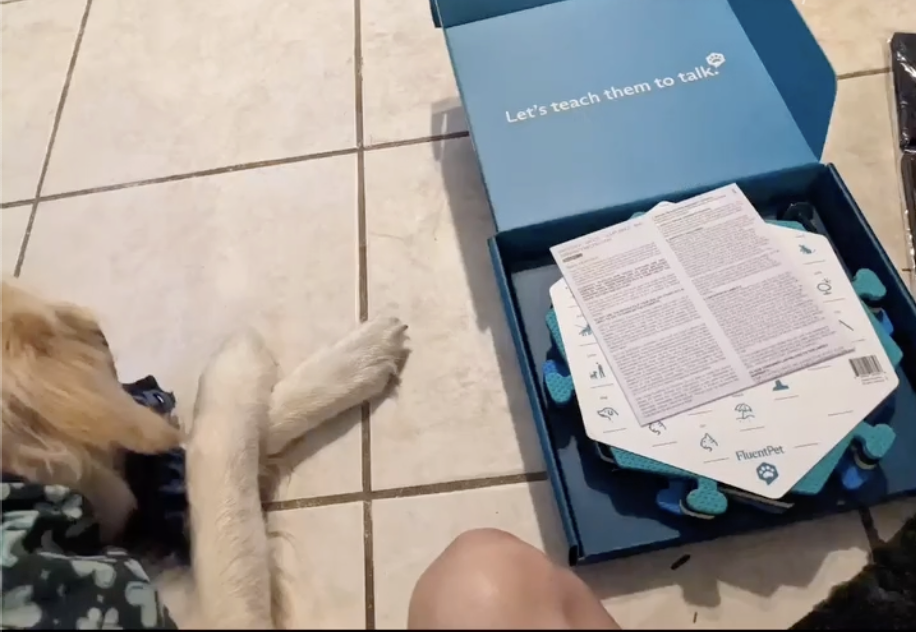
I decided to record her “outside” button first with that original goal in mind. I placed it by the front door and our journey began. (Daisy was a year and four months old at the time.) Daisy pressed it the first day and when she gleefully discovered what that button meant we were off and running. I added “water” by the water bowl and “play” by the basket we keep the dog toys in, as her next words a week later. She immediately figured out she could combine verbal and non-verbal clues to express herself. One morning when I ran errands during our usual morning walk time she pressed “outside” and then walked to her leash hook and looked at me. Once we were getting traction with the first three buttons, I got excited, probably too excited, and added “potty”, “come” and “nap” and moved all the buttons onto foam mats near her dog bed. She used “outside” in its new location twice that first night.
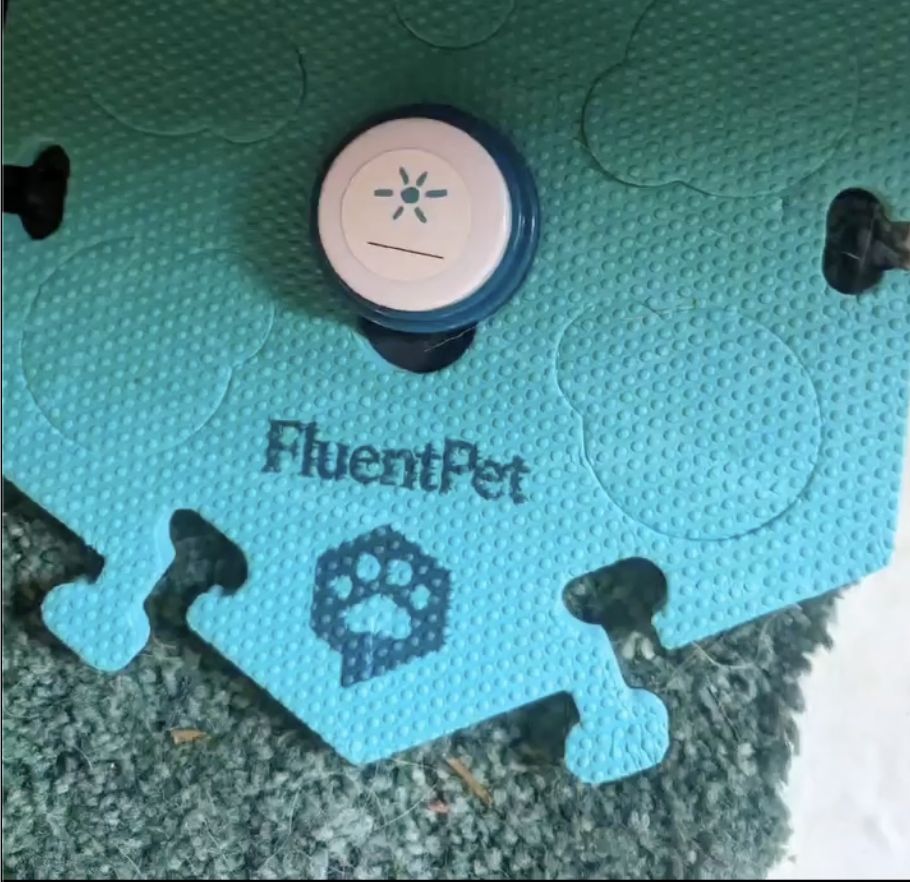
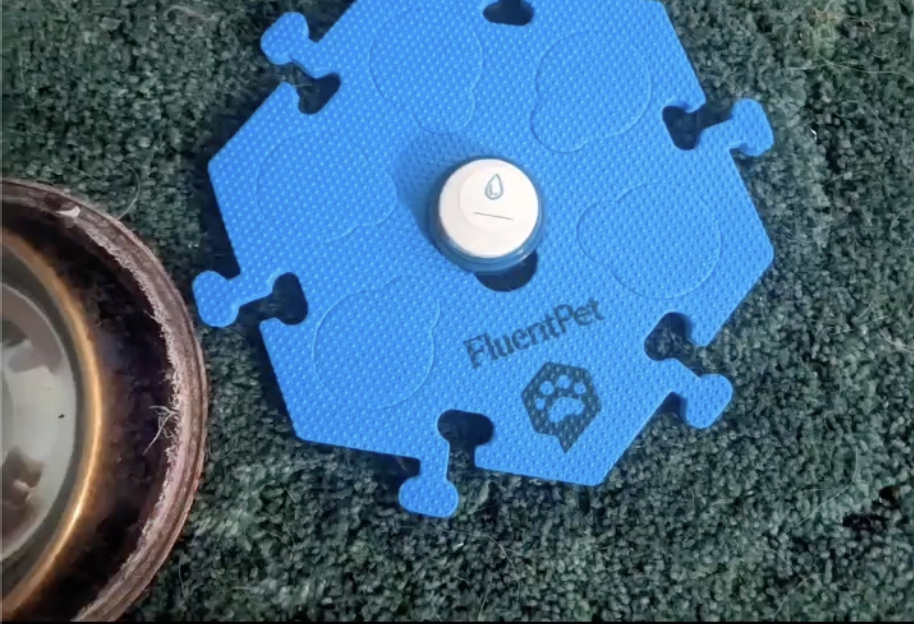

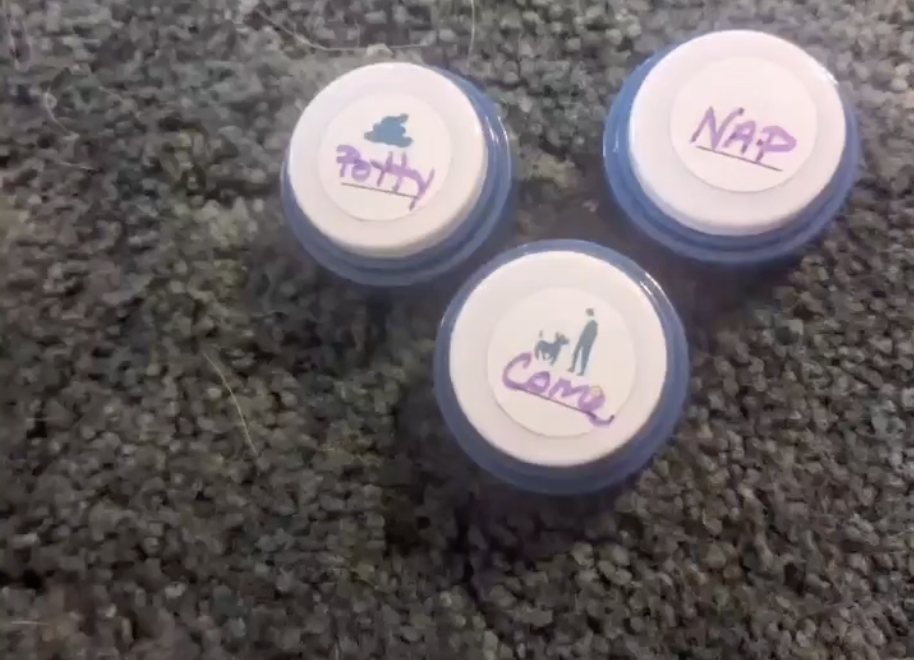
Adding more buttons
When we were well over a month into the button experiment, I ordered more buttons. I added “Walk”, “Food”, “Mommy”, “Daddy”, “Mr. Fu”, “Riley”, “Later”, “Park”, “All Done” and “Help”. Daisy seemed very interested, so I pressed each button on her board one at a time saying them as well, but she wandered away before I was done. We kept modeling things (pressing buttons before we did their actions) for her. At one point about an hour later, Daisy walked over unprompted and pressed “Park” “Outside”. I was shocked! Yes! “Park”, “outside”, I said and pressed them. I ran to her leash repeating “Yes, Park, Outside!” And we were off.
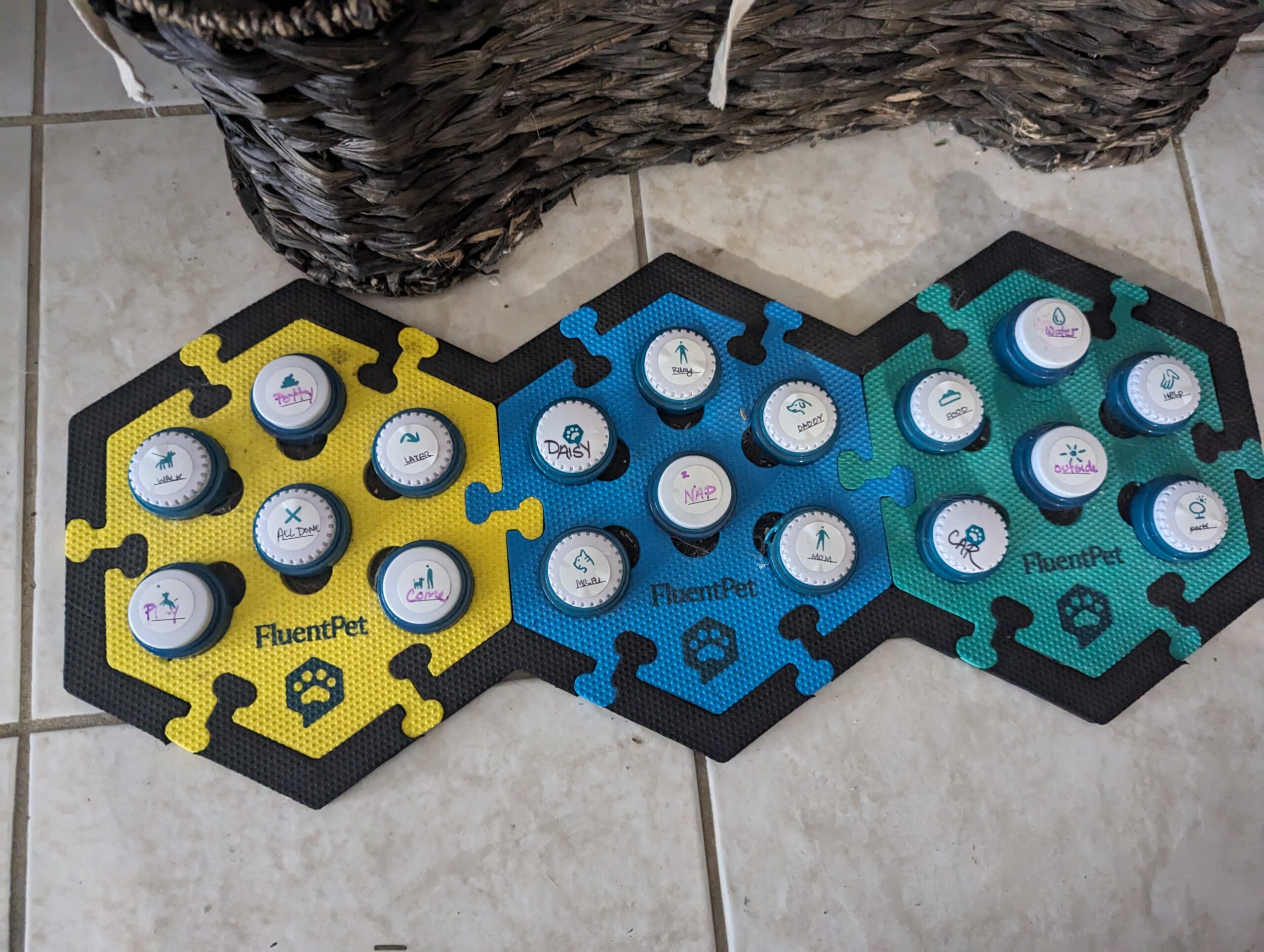
Different species have different uses for language
As time went on, I realized she never uses the buttons the way I would. For example, if she wants her nap snack, she presses “Mr. Fu” (the name of our cat) because the cat always gets cat treats at the same time that she gets a little kibble and takes her nap. I would press “nap” or “dog food”, but it was highly effective to press “Mr. Fu” and then go sit by her bowl so Daisy continued doing that. Most people are worried that once they have buttons all their dog will do is ask for food, but I learned that, as food driven as Daisy is, her schedule is her top priority at all times.
Names for family members when dogs use buttons to talk
The other day when my teenager was absorbed in her phone Daisy pressed “Riley” twice, checked to see if she had her attention and only then pressed “play”. “Play” is her most pressed button by a landslide! It was the first button to need a battery change. We had guests over after the holidays and Daisy was enjoying the humans and their small dog, but when nap time passed, she went over to her buttons and pressed “come” and “later” and looked at our company and laid down with a heavy sigh.
Daisy only goes to her buttons if she can see us. I think she associates us being in visual range with us being able to hear her. Daisy also relies on a combination of verbal and non-verbal communication to express herself, tending to use more non-verbal indicators than buttons, but she only has 18 words to choose from at present so that is understandable. She has never used the “mommy” button but has summoned every other member of the family (especially the cat). Our working theory is that I am usually paying the most attention and definitely am the most on top of her schedule.
Complex sentences when dogs use buttons to talk
Her longest sentence so far was when my husband and I were both busy working on separate projects in the living room recently and she pressed “all done” looked at him and waited then pressed “outside”, “walk” and “play”. She hadn’t been on a walk to the big park in quite a while and she wanted us to stop working and take her!
Patience is key when teaching a dog to use buttons to talk
As with all learning, this process is non-linear, there are weeks with very little button pressing and days with tons. The way Dr. Hunger explains it in her book is that dogs have about a toddler’s level of communication skills. That helps me keep it in perspective when Daisy would rather nudge, point, growl, or even bark in a frustrated moment than “talk”. Currently, we are due for some new buttons and maybe some button swapping. Knowing that Daisy uses language differently than I imagine she will means it is important that she has options if we want her to keep expressing herself.
As funny, heartwarming and downright amazing as some of those internet pets are, my best advice is don’t compare! Your pet is going to value communication differently than someone else’s and because they can’t tell you which words they need most, it’s trial and error for both of you in the beginning (just like training). I thought I would order the buttons and a webcam and start making talking dog videos like I was seeing on YouTube. We have ONE video of Daisy pressing a button, it’s the first time she pressed “outside.” The minute I aim a phone at Daisy, she’s sure my attention is divided and is not interested in pressing her buttons. I think that’s a good thing and speaks directly to our bond as a service dog and handler team. Forget the dog that made you laugh until you cried calling out its owners farts or that cat that demanded its owner remove their yoga mat from the living room floor; this is the unique journey of you and your dog.
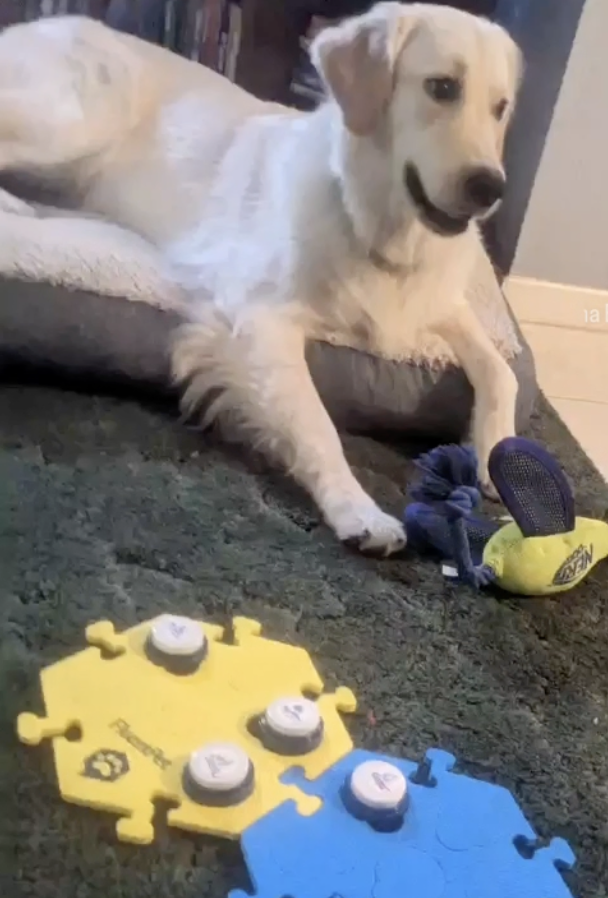
Buttons are a tool like a mobility aid or a gentle leader; some days they’re what’s needed and maybe some days they won’t be. Patience is so important! None of those regularly-posting accounts woke up one day to their dog pressing buttons to form logical sentences without a lot of time, practice, and loving encouragement. I do hope one day we get the magic number and combination of words right for Daisy to express herself to the best of her ability, but her needs may change and her vocabulary may grow, shrink or change (just like a human’s). For now, the buttons are serving a purpose and it makes Daisy happy to say what she means and to feel heard. I am still delighted every single time she “talks” to me!
Guest Author – Katie Calahan: I’m an actress/writer/director and run a local children’s theater program. I received my classical training and my BFA in Theatre Studies from Boston University. I’m a native Floridian (We DO Exist!), but I’ve lived in Boston, New York, Dublin and LA. I’m currently based in the good old sunshine state, but more than happy to travel. I love an adventure! I love Shakespeare, dessert, kayaking, Bob’s Burgers, a great book, Disney, and my golden retriever!

Nothing in ELLAS Animals INC’s website or blog is intended as medical, legal, or financial advice. We receive no compensation for recommendations or reviews.
